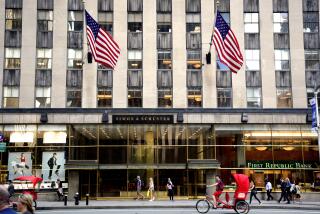Media titan S.I. Newhouse dies at 89; low-profile publisher of high-profile magazines
Reporting from NEW YORK — S.I. Newhouse Jr., the low-profile billionaire media mogul who ran the parent company of some of the nation’s most prestigious magazines, died Sunday. He was 89.
Newhouse’s death was confirmed by his family, who said he died at his New York home.
The chairman of Conde Nast since 1975, Si Newhouse, as he was known, bought and remade The New Yorker and Details magazines and revived Vanity Fair. Other magazines in the Conde Nast stable included Vogue, Wired, Glamour, W, GQ, and Self.
The glossy titles helped set the nation’s tastes, reached millions of aspirational readers and appealed to upscale advertisers.
“In all realms, he wanted Conde Nast — and its writers, artists and editors — to be at the center of the cultural conversation,” Bob Sauerberg, the company’s CEO, wrote to staff in announcing Newhouse’s death.
As Newhouse himself put it in a rare 1988 interview with The New York Times, “Our magazines represent a certain tone and audience.”
Under Newhouse, Conde Nast was famously extravagant, paying editors huge salaries, throwing lavish parties and rarely sticking to budgets — if budgets existed at all. Its expense accounts were legendary, with dresses flown from Paris to New York on the Concorde and elephants brought in to menace models at fashion shoots.
“He was passionate about journalism and he supported journalists and editors,” his nephew Steven Newhouse, who is the chairman of Advance Publications Inc., which owns Conde Nast, told The Associated Press. “He set an example of caring about the right things in media, which is great stories, great design, great magazines, great websites.”
Newhouse’s vision extended beyond magazines. Before selling the Random House book publishing empire, he spotted a magazine profile about a rising young real estate mogul and commissioned the first book of a future president: Donald Trump’s “The Art of the Deal.”
Some of his editors became celebrities in their own right.
“He loves magazines, meaning the whole and all of it, the variety of things published, the business details, the visions and actions and personalities of his editors, the problems, the problem-solving, the ink and paper,” New Yorker editor David Remnick told New York magazine in 2009.
Newhouse also brought in buzz-obsessed Britons Anna Wintour and Tina Brown as editors, while abruptly firing staffers who fell from his graces. Grace Mirabella learned she was being axed as editor-in-chief of Vogue in June 1988 when her husband saw it on TV.
That same year, Val Weaver was let go as head of Self magazine when Newhouse knocked on her door and asked, “Would you mind if we made a change in editors in chief?” according to a 1995 biography of Newhouse by Thomas Maier.
Newhouse said the company that his father bought in 1959 for $5 million was following in the tradition of its founder, Conde Montrose Nast.
The company struggled in recent years with the advertising meltdown. Since 2007 it has closed magazines including Gourmet, Modern Bride, House & Garden and Golf for Women. The ambitious business magazine Portfolio shuttered in April 2009 just two years after its launch, burning through an estimated $100 million.
Forbes said in March 2009 that the downturn had sliced Newhouse’s fortune in half, but his estimated net worth of $4 billion still left him among the world’s richest men. Newhouse and his brother, Donald, owned New York-based Advance Publications Inc., which in addition to Conde Nast has over 20 daily newspapers in the U.S. and a cable television company.
Unlike other media moguls who seemed obsessed with building an empire to make money, influence opinion or bask in the spotlight, Newhouse seemed to have no grand plan. He rarely spoke to the media and had no discernible political views.
Many hands were wrung when Newhouse bought The New Yorker in 1985. In 1992, he brought in Tina Brown from Vanity Fair, who transformed the idiosyncratic literary journal into a more newsy read with shorter stories, a staff photographer and splashier color.
Newhouse lived with his wife, Victoria, an architectural historian, in a Manhattan apartment near the United Nations and in a house in Bellport, Long Island. Newhouse had two sons and a daughter by his first wife, Jane Franke.
A former member of the board of the Museum of Modern Art, Newhouse had a major collection including works by Picasso, Andy Warhol and Jasper Johns. He was also a major movie buff and enjoyed theater and the opera.
Samuel Irving Newhouse Jr. was born Nov. 7, 1927, in Staten Island, the grandson of Russian Jewish immigrants. His father, Sam Newhouse, bought the Staten Island Advance in 1922 and used its profits to purchase more papers, eventually including The (Cleveland) Plain Dealer, The (New Orleans) Times-Picayune, The (Portland) Oregonian and two papers he merged to create The (Newark, New Jersey) Star-Ledger.
Newhouse attended the elite Horace Mann high school in the Bronx, where his classmates included Roy Cohn, a lifelong friend. Cohn went on to become a New York powerbroker and aide to Sen. Joseph McCarthy.
Newhouse had a tough time at Syracuse University, dropping out his junior year. But he remained connected to the school, a supporter of its S.I. Newhouse School of Public Communications, named for his father, its founder. He worked at his father’s newspapers for a time but never very seriously. He married, divorced and seemed to enjoy an indulgent playboy lifestyle.
But by the mid-60s Newhouse made his way into Conde Nast, the one place in the family business where his father had shown little interest, and found his niche.
UPDATES:
9:28 a.m.: This article was updated with reaction and additional details on Newhouse.
This article was original published Oct. 1 at 5 p.m.
More to Read
Start your day right
Sign up for Essential California for the L.A. Times biggest news, features and recommendations in your inbox six days a week.
You may occasionally receive promotional content from the Los Angeles Times.






